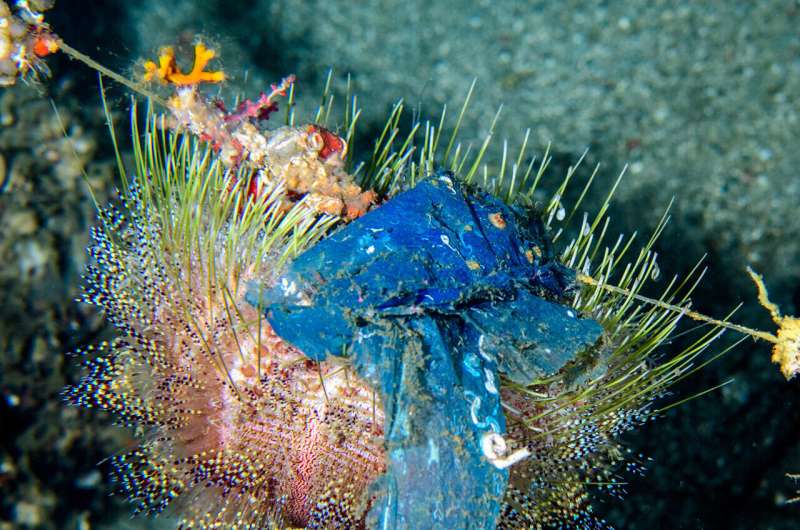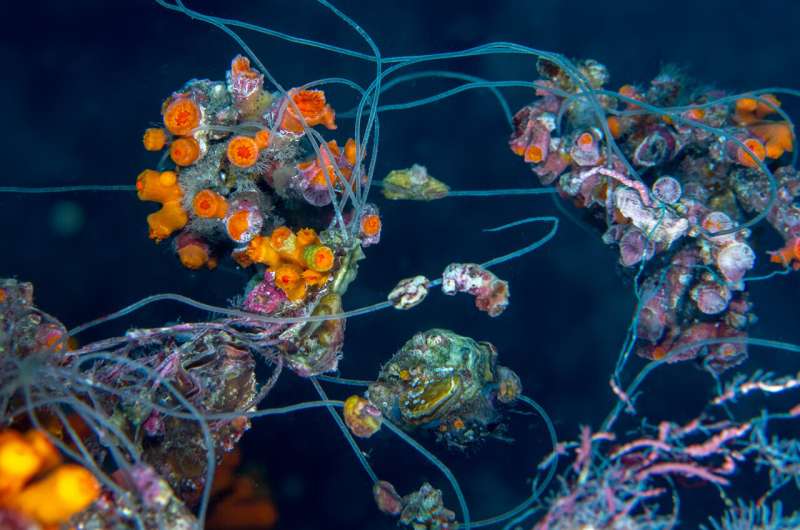This article has been reviewed according to Science X's editorial process and policies. Editors have highlighted the following attributes while ensuring the content's credibility:
fact-checked
peer-reviewed publication
trusted source
proofread
Plastic pollution on coral reefs increases with depth and mostly comes from fishing activities, study finds

In a paper published in Nature, researchers from the California Academy of Sciences, University of São Paulo, University of Oxford, University of Exeter, and other collaborators reveal the extent of plastic pollution on coral reefs, finding that debris increases with depth, largely stems from fishing activities, and is correlated with proximity to marine protected areas.
Through underwater visual surveys spanning more than two dozen locations across the Indian, Pacific, and Atlantic oceans, the researchers expose the abundance, distribution, and drivers of plastic pollution at various depths, which in turn enables them to identify what conservation efforts could be prioritized—and where—to protect our planet's vulnerable coral reefs.
"Plastic pollution is one of the most pressing problems plaguing ocean ecosystems, and coral reefs are no exception," says Hudson Pinheiro, Ph.D., the study's lead author, a biologist at the Center for Marine Biology of the University of São Paulo, and an Academy research fellow.
"From macroplastics that spread coral diseases to fishing lines that entangle and damage the structural complexity of the reef, decreasing both fish abundance and diversity, pollution negatively impacts the entire coral reef ecosystem."
Surveying reefs from shallow to never-before-seen
For the study, the researchers conducted more than 1,200 visual surveys across 84 shallow and mesophotic reef ecosystems located in 14 countries. To survey hard-to-reach mesophotic—or "twilight zone"—coral reefs that exist between 100 and 500 feet (30 and 150 meters) deep, researchers relied on specialized diving gear that few other scientific dive teams are trained to safely use.
According to the study, coral reefs appear to be more contaminated by plastics and other human-derived debris than other marine ecosystems that have been evaluated, but are much less polluted than shoreline ecosystems like beaches and wetlands.
However, contrary to studies of near-shore environments, the researchers found that the amount of plastic increased with depth—peaking in the mesophotic zone—and was mostly derived from fishing activities.

"It was surprising to find that debris increased with depth since deeper reefs in general are farther from sources of plastic pollution," says Luiz Rocha, Ph.D., Academy curator of ichthyology and co-director of the Academy's Hope for Reefs nitiative, who was the senior author on the study. "We are almost always the first humans to set eyes on these deeper reefs, and yet we see human-produced trash on every dive. It really puts the effect we have had on the planet into perspective."
Of the total debris, 88% was macroplastics larger than about two inches (five centimeters). The researchers posit that the potential causes of pollution reaching such depths include increased wave action and turbulence near the surface dislodging trash and carrying it away, recreational divers removing debris from more accessible shallow reefs, and shallow corals with higher growth rates overgrowing the trash hiding it from their surveys.
The lowest and highest densities of pollution
Over the course of the study, the researchers found human-derived debris in nearly all locations, including some of the planet's most remote and pristine coral reefs, such as those adjacent to uninhabited islands in the central Pacific.
The lowest densities of pollution—around 580 items per square kilometer—were observed in locations such as the Marshall Islands. Comoros, an island chain off the southeast coast of Africa, had the highest density of pollution with nearly 84,500 items per square kilometer—the equivalent of around 520 pieces of debris on one football field.
Troublingly, the researchers say that because these plastic-laden deeper reefs are more difficult to study, they are rarely included in conservation efforts, management targets, and discussions despite harboring unique biodiversity that's often not found on shallow reefs.
"Our findings provide more evidence that the mesophotic is not a refuge for shallow reef species in a changing climate as we once thought," says co-author Bart Shepherd, director of the Academy's Steinhart Aquarium and co-director of Hope for Reefs. "These reefs face many of the same pressures from human society as shallow reefs, and have a unique and poorly-studied fauna. We need to protect deeper reefs and make sure that they are included in the conservation conversation."
Fishing gear foremost source of pollution
Although the researchers found much consumer debris, such as water bottles and food wrappers, which are often the main source of plastic pollution in other ecosystems, nearly three-quarters of all plastic items documented on the surveyed reefs were related to fishing like ropes, nets, and fishing lines.

"Fishing gear, which even as debris continues to catch marine life through what we call ghost fishing, appears to contribute a large proportion of the plastic seen on mesophotic reefs," says co-author Lucy Woodall, Ph.D., principal scientist of Nekton and associate professor in marine conservation biology and policy at University of Exeter.
"Unfortunately, fishing gear debris is often not reduced by general waste management interventions; therefore specific solutions related to the needs of fishers should be considered, such as no-charge disposing of damaged gear in ports or individually labeling gear to ensure fishers take responsibility for misplaced equipment."
To uncover the drivers of coral reef pollution, the researchers analyzed how the abundance of human-derived debris correlated with a number of geographic and socioeconomic factors. In general, they found pollution on reefs increases with depth and proximity to densely populated cities, local markets, and, counter-intuitively, marine protected areas. Since most marine protected areas allow some fishing within or near their borders and are typically more productive than other locations due to their protected status, they are often heavily frequented by fishers, according to the researchers.
"Our findings reveal some of the complex collective challenges we face when dealing with plastic pollution," Pinheiro says. "As marine resources around the world dwindle, humans that rely on those resources are turning to deeper habitats and those closer to marine protected areas where fish remain abundant."
Science-based solutions to fight reef pollution
Ultimately, the researchers hope that by teasing out the major drivers of pollution, as well as demonstrating that plastic pollution increases with depth, conservation efforts can be redirected to better protect and ensure a thriving future for Earth's coral reefs.
"The results of our global study shine a light on one of the many threats that deep reefs face today," says study author and University of Oxford marine biologist Paris Stefanoudis. "Because these ecosystems are ecologically and biologically unique, much like their shallow-water cousins, they need to be conserved and explicitly considered in management plans."
In particular, they stress the need to expand the depth of marine protected areas to include mesophotic reefs, update international agreements on combating plastic pollution at their source—such as those discussed at the recent Intergovernmental Negotiating Committee on Plastic Pollution—to include fishing gear, and develop low-cost biodegradable alternatives to fishing gear that will not adversely impact the well-being of coastal communities that rely on sustainable fishing for their livelihoods.
"Despite the disturbing overall trend, there were some places where we found relatively little debris, which shows us that there are effective strategies for preventing plastic pollution," Shepherd says. "If we act fast and employ science-based solutions, there absolutely is hope for coral reefs."
More information: Hudson T. Pinheiro et al, Plastic pollution on the world's coral reefs, Nature (2023). DOI: 10.1038/s41586-023-06113-5
Journal information: Nature
Provided by California Academy of Sciences





















